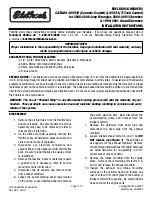
2.1.3
Seat belt buckle - visual inspection
– Check belt buckle for fractures and flaking.
• In case of damage, the seat belt and the belt buckle must be
replaced.
2.1.4
Seat belt buckle - functional check
Checking seat belt buckle:
– Insert buckle latch in the belt buckle until there is an audible
click. Check whether the locking mechanism engages, by tug‐
ging forcefully on the seat belt.
• If the buckle latch fails to lock into the buckle even once out of
at least five tests, replace the seat belt together with the buck‐
le.
Check buckle release:
– Release seat belt by pressing the seat belt buckle button.
– If the belt is loose, the latch must eject independently from the
belt buckle.
• Test at least 5 times. If the buckle latch fails to eject even once,
replace the seat belt together with the buckle.
WARNING
Never use lubricants to eliminate noises or to smoothen the
operation of the buttons on seat buckles.
2.1.5
Checking deflection fitting and buckle
latch
When the belt system is burdened (seat belt attached in an acci‐
dent) plastic-coated fittings will display fine parallel score marks.
(Normal wear and tear due to frequent use is recognisable by
smooth, even wear, without scoring.)
– Check the plastic for deformation, flakings and crackings.
• In the event of scoring and/or damage replace seat belt to‐
gether with buckle.
2.1.6
Checking fixings and fixing points
♦ Buckle tongue deformed (stretched).
♦ Fixing points (seat, pillar, underfloor) warped, or thread dam‐
aged.
• If the parts are damaged replace seat belt together with buck‐
le.
• Replace fixing points.
Note
If damage has occurred that is not due to an accident, but is the
result, for example, of normal wear and tear, it is only necessary
to replace the damaged part.
Rapid NH 2014 ➤ , Rapid Spaceback 2014 ➤
Body Work - Edition 10.2018
222
Rep. gr.69 - Passenger protection
















































